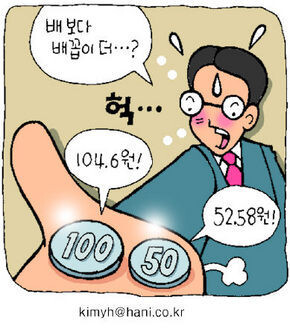hankyoreh
Links to other country sites 다른 나라 사이트 링크
When a coin can no longer be taken at face value

As the price of the metals used to make South Korean coins has risen rapidly, the cost of the materials inside the coins has surpassed their face value.
As of early this month, nickel is being traded at US$52,150 per ton on the London Metal Exchange, a nearly fourfold increase from $13,372 per ton in late 2005. Copper and zinc are being traded at around $7,390 and $3,440 per ton, respectively.
A 100-won coin is made of 25 percent nickel and 75 percent copper, while a 50-won coin is 12 percent nickel, 70 percent copper and 18 percent zinc. As a result, as of April 12, the cost of materials to make a 100-won coin was 104.60 won, and to make a 50-won coin cost 52.58 won. It would thus be more profitable to sell the metals used in making the coins than to use the coins as currency. This is not considering the expense of gathering and transporting the coins as well as melting them down and purifying the metals, of course. And there is the issue of legality.
Summarily, the Bank of Korea has started to consider replacing metals used for making 100-won and 50-won coins with less costly ones. Because the price of materials used in making the 10-won coin exceeded its face value, the central bank at the end of last year introduced new, smaller, cheaper-to-make 10-won coins using aluminum instead of copper. But the Bank of Korea faces an uphill battle, as worldwide prices of raw materials are seeing a rapid hike.
Please direct questions or comments to [englishhani@hani.co.kr]
Editorial・opinion
![[Column] Park Geun-hye déjà vu in Yoon Suk-yeol [Column] Park Geun-hye déjà vu in Yoon Suk-yeol](https://flexible.img.hani.co.kr/flexible/normal/500/300/imgdb/original/2024/0424/651713945113788.jpg) [Column] Park Geun-hye déjà vu in Yoon Suk-yeol
[Column] Park Geun-hye déjà vu in Yoon Suk-yeol![[Editorial] New weight of N. Korea’s nuclear threats makes dialogue all the more urgent [Editorial] New weight of N. Korea’s nuclear threats makes dialogue all the more urgent](https://flexible.img.hani.co.kr/flexible/normal/500/300/imgdb/original/2024/0424/7317139454662664.jpg) [Editorial] New weight of N. Korea’s nuclear threats makes dialogue all the more urgent
[Editorial] New weight of N. Korea’s nuclear threats makes dialogue all the more urgent- [Guest essay] The real reason Korea’s new right wants to dub Rhee a founding father
- [Column] ‘Choson’: Is it time we start referring to N. Korea in its own terms?
- [Editorial] Japan’s rewriting of history with Korea has gone too far
- [Column] The president’s questionable capacity for dialogue
- [Column] Are chaebol firms just pizza pies for families to divvy up as they please?
- [Column] Has Korea, too, crossed the Rubicon on China?
- [Correspondent’s column] In Japan’s alliance with US, echoes of its past alliances with UK
- [Editorial] Does Yoon think the Korean public is wrong?
Most viewed articles
- 1‘We must say no’: Seoul defense chief on Korean, USFK involvement in hypothetical Taiwan crisis
- 2Will NewJeans end up collateral damage in internal feud at K-pop juggernaut Hybe?
- 3[Column] Park Geun-hye déjà vu in Yoon Suk-yeol
- 4Why Korea shouldn’t welcome Japan’s newly beefed up defense cooperation with US
- 5Thursday to mark start of resignations by senior doctors amid standoff with government
- 6N. Korean hackers breached 10 defense contractors in South for months, police say
- 7[Guest essay] The real reason Korea’s new right wants to dub Rhee a founding father
- 8[Column] ‘Choson’: Is it time we start referring to N. Korea in its own terms?
- 9Kim Jong-un expressed ‘satisfaction’ with nuclear counterstrike drill directed at South
- 10[Editorial] New weight of N. Korea’s nuclear threats makes dialogue all the more urgent